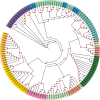Genetic structure of an endangered species Ormosia henryi in southern China, and implications for conservation
- PMID: 37098472
- PMCID: PMC10131447
- DOI: 10.1186/s12870-023-04231-w
Genetic structure of an endangered species Ormosia henryi in southern China, and implications for conservation
Abstract
Background: The evergreen broadleaved forest (EBLF) is an iconic vegetation type of East Asia, and it contributes fundamentally to biodiversity-based ecosystem functioning and services. However, the native habitat of EBLFs keeps on decreasing due to anthropogenic activities. Ormosia henryi is a valuable rare woody species in EBLFs that is particularly sensitive to habitat loss. In this study, ten natural populations of O. henryi in southern China were sampled, and then genotyping by sequencing (GBS) was applied to elucidate the standing genetic variation and population structure of this endangered species.
Results: In ten O. henryi populations, 64,158 high-quality SNPs were generated by GBS. Based on these markers, a relatively low level of genetic diversity was found with the expected heterozygosity (He) ranging from 0.2371 to 0.2901. Pairwise FST between populations varied from 0.0213 to 0.1652, indicating a moderate level of genetic differentiation. However, contemporary gene flow between populations were rare. Assignment test and principal component analysis (PCA) both supported that O. henryi populations in southern China could be divided into four genetic groups, and prominent genetic admixture was found in those populations located in southern Jiangxi Province. Mantel tests and multiple matrix regression with randomization (MMRR) analyses suggested that isolation by distance (IBD) could be the possible reason for describing the current population genetic structure. In addition, the effective population size (Ne) of O. henryi was extremely small, and showed a continuous declining trend since the Last Glacial Period.
Conclusions: Our results indicate that the endangered status of O. henryi is seriously underestimated. Artificial conservation measures should be applied as soon as possible to prevent O. henryi from the fate of extinction. Further studies are needed to elucidate the mechanism that leading to the continuous loss of genetic diversity in O. henryi and help to develop a better conservation strategy.
Keywords: Conservation; Genetic diversity; Genotyping by sequencing; Ormosia henryi; Population structure.
© 2023. The Author(s).
Conflict of interest statement
The authors declare no competing interests.
Figures






References
-
- Song YC, Da LJ. Evergreen broad-leaved forest of East Asia. In: Box EO, editor. Vegetation structure and function at multiple spatial, temporal and conceptual scales. Switzerland: Springer International; 2016. pp. 101–128.
-
- Tang CQ. Evergreen broad-leaved forests. In: Tang CQ, editor. The subtropical vegetation of southwestern China: plant distribution, diversity and ecology. Dordrecht: Springer; 2015. pp. 49–112.
-
- Dong M, Zang RG. Research in population and conservation biology of rare and endangered plant species. Beijing: Science Press; 2022.
MeSH terms
Grants and funding
- 20236/Forestry Science and Technology Innovation Project of Jiangxi Forestry Bureau
- 20236/Forestry Science and Technology Innovation Project of Jiangxi Forestry Bureau
- 20236/Forestry Science and Technology Innovation Project of Jiangxi Forestry Bureau
- 20236/Forestry Science and Technology Innovation Project of Jiangxi Forestry Bureau
- 2023521202/Special Fund of Fundamental Research and Talents of Jiangxi Academy of Forestry
- 2023521202/Special Fund of Fundamental Research and Talents of Jiangxi Academy of Forestry
- 2023521202/Special Fund of Fundamental Research and Talents of Jiangxi Academy of Forestry
- 2023521202/Special Fund of Fundamental Research and Talents of Jiangxi Academy of Forestry
- 2023521202/Special Fund of Fundamental Research and Talents of Jiangxi Academy of Forestry
- 2023521202/Special Fund of Fundamental Research and Talents of Jiangxi Academy of Forestry
- 2017511201/Major Programs of Scientific Research and Achievement Popularization of Jiangxi Academy of Forestry
- 2017511201/Major Programs of Scientific Research and Achievement Popularization of Jiangxi Academy of Forestry
- 2017511201/Major Programs of Scientific Research and Achievement Popularization of Jiangxi Academy of Forestry
- 2017511201/Major Programs of Scientific Research and Achievement Popularization of Jiangxi Academy of Forestry
- 2017511201/Major Programs of Scientific Research and Achievement Popularization of Jiangxi Academy of Forestry
LinkOut - more resources
Full Text Sources
Miscellaneous

